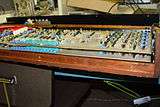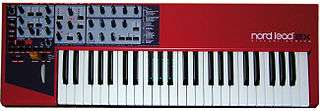Sequential Circuits Prophet-5
| Prophet-5 | |
|---|---|
 | |
| Manufacturer | Sequential Circuits |
| Dates | 1978–84 |
| Price |
US$3,995 (Rev 1, 2) US$4,595 (Rev 3) |
| Technical specifications | |
| Polyphony | 5 voices |
| Timbrality | Monotimbral |
| Oscillator | 2 VCOs per voice |
| LFO | 1 |
| Synthesis type |
Analog subtractive Analog FM (Poly-Mod) |
| Filter | 4-pole resonant low-pass |
| Attenuator | ADSR envelope (2) |
| Aftertouch expression | No |
| Velocity expression | No |
| Storage memory | 40 patches (120 patches on later units) |
| Effects | None |
| Input/output | |
| Keyboard | 61 keys |
| Left-hand control | Pitch and modulation wheels |
| External control | CV/Gate |
The Prophet-5 is an analog synthesizer manufactured by Sequential Circuits between 1978 and 1984. With five voices of polyphony, the Prophet-5 was the first fully programmable polyphonic synthesizer and the first musical instrument with an embedded microprocessor. About 6,000 units were produced in three revisions by Dave Smith and John Bowen. This was later accompanied by the Prophet-10, a version with ten voices of polyphony through an additional circuit board and keyboard.
The Prophet-5 is known for its use by progressive rock bands and film composers. Due to its success, the Prophet-5 has been emulated in software synthesizers and analog hardware. Through his company Dave Smith Instruments, and later under the Sequential Circuits brand, Smith has developed updated versions of the Prophet-5.
Production
The Prophet-5 was created in 1977 by Dave Smith and John Bowen for Sequential Circuits, who aimed to create the first polyphonic synthesizer with the ability to store and recall patches.[1] Initially, they developed the Prophet-10, a synthesizer with ten voices of polyphony; however, it was unstable and quickly overheated, creating tuning problems. Smith and Bowen removed half the electronics, reducing the voices to five and creating the Prophet-5.[1]
Three versions were built between 1978 and 1984. The first, Revision 1, was hand-assembled and produced quickly to generate initial revenue; only 182 were made. Revision 2 was mass-produced in quantities over 1,000; this model was more robust, added cassette patch storage, and replaced the koa wood casing with walnut.[1]
Revision 3 replaced the Solid State Music (SSM) chipset with Curtis (CEM) chips, necessitating a major redesign of the synthesizer; according to Sound on Sound, this version "remained impressive and pleasant to play, but was slightly cold and featureless by comparison to earlier models".[1] Inclusive of all revisions, approximately 6,000 units were produced.[1]

Following the success of the Prophet-5, Smith and Bowen reintroduced the Prophet-10, assembled from two Revision 3 Prophet-5 soundboards, played with two separate keyboards. Early Prophet-10s were still prone to overheating and unstable tuning, as well as memory problems. The Prophet-10 was not as successful as the Prophet-5.[1]
Artists who have used the Prophet 5 include John Carpenter and Alan Howarth,[2] Talking Heads, Madonna,[3] Too Short, and Radiohead.[4]
Synthesis model
Early Prophet-5s used voltage-controlled oscillator, filter and amplifier chips designed by E-mu Systems and manufactured by Solid State Music (SSM). Revision 3 Prophet-5s used Curtis CEM chips manufactured by Curtis Electromusic Specialties. Some owners maintain that SSM oscillators produced a richer timbre.[5] However, the SSM oscillators rendered the instruments unstable and prone to detuning over time. CEM chips have remained more stable.[6]
The Prophet-5 uses five voices of polyphony. Each voice is assigned two VCOs. Both oscillators can generate sawtooth waves and square waves (with variable pulse width), and the second oscillator can also generate a triangle. The oscillators can be played in sync, or in "Poly-Mod", with oscillator B and the filter ADSR envelope modulating the frequency, pulse width, and filter of oscillator A. A dedicated low-frequency oscillator (saw, square, or triangle) is also present to modulate the pulse width and/or pitch of oscillators A and B and filter cutoff frequency.[5]
The Prophet-5 uses a 4-pole resonant low-pass filter. The filter has a dedicated ADSR envelope and keyboard tracking.
Clones and emulators
Software

Arturia developed a softsynth version of the Prophet 5 called the Prophet V. Prophet V also includes a recreation of the Prophet VS, a synthesizer manufactured by Sequential Circuits in 1986. Elements of the two synthesizers can be combined in a "hybrid" mode. The softsynth closely recreates the layout of the original analog synthesizer, though there were some differences in programming, notably through some restrictions on the envelope generator.[7]
Other software emulations of the Prophet-5 include Pro-53, a Virtual Studio Technology and Audio Unit by Native Instruments (discontinued in 2009), Prophecizer 5 by Analog Synth Lab, and the Pro-12 by Creamware. The Pro-12 emulates the early revisions' SSM filter. Creamware also developed and manufactured a hardware version of the Pro-12 called the Pro-12 ASB. Steinberg's Cubase has the stock plugin Retrologue.
Hardware


Dave Smith Instruments celebrated the 30th anniversary of the Prophet by developing the Prophet '08, an 8-voice analog synthesizer. Smith was the owner of Sequential Circuits until it went out of business in the late 1980s when the rights were purchased by Yamaha and later sold to Korg. Smith was a consultant for Yamaha and Korg for a number of years following the acquisition. He was largely responsible for Korg's successful Wavestation series of vector-synthesis-based instruments.
With access to the technology used to create the Prophet-5, Yamaha developed the 1997 virtual analog synthesizer keyboard, the AN1x. Many of its features were modelled upon the Prophet-5. The AN1x surpassed capabilities of the Prophet-5, with a doubled 10 notes of polyphony and various other features either modelled on other popular analog synthesizers or representing new additions made feasibly only by the underlying digital technology.
In January 2015, Smith announced that Yamaha's president, Takuya Nakata, had granted him rights to the Sequential brand, which he had been unable to use following the company's acquisition. The release of the name coincided with Smith's debut of the Prophet-6, a new analog polyphonic synthesizer based on the Prophet-5 with additional features. Of the Prophet-6, Smith said "I wanted to celebrate the return of Sequential in the best way I could—by building the most awesome-sounding, modern analog poly synth possible. The Prophet-6 is a tribute to Sequential’s most famous instrument, the Prophet-5. I think of it as vintage with a modern twist."[8]
References
- 1 2 3 4 5 6 Reid, Gordon (March 1999). "Sequential Circuits – Prophet Synthesizers 5 & 10 (Retro)". Sound On Sound. Archived from the original on 3 February 2016. Retrieved January 23, 2015.
- ↑ Paul Tingen. "John Carpenter - Film Director & Composer". Sound On Sound. No. July 2016.
- ↑ Richard Buskin. "Madonna 'Like a Virgin'". Sound On Sound. No. September 2007. Retrieved 2016-07-31.
- ↑ "The 14 synthesizers that shaped modern music". The Vinyl Factory. 2014-03-04. Retrieved 2018-03-05.
- 1 2 "Sequential Circuits Prophet 5". Vintage Synth Explorer. Retrieved 2015-12-26.
- ↑ Forrest, Peter (1996). The A-Z of Analogue Synthesisers Part Two. Short Run Press Ltd. p. 114.
- ↑ Reid, Gordon (September 2006). "Arturia Prophet V". Sound on Sound. Retrieved January 23, 2015.
- ↑ "Sequential is Back!". Dave Smith Instruments. January 22, 2015. Retrieved January 23, 2015.
Further reading
| Wikimedia Commons has media related to Sequential Circuits Prophet-5. |
- "Retro: SCI Prophet 5". Future Music. No. 47. Future Publishing. September 1996. p. 53. ISSN 0967-0378. OCLC 1032779031.
.jpg)
